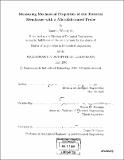Measuring mechanical properties of the tectorial membrane with a microfabricated probe
Author(s)
Gu, Jianwen Wendy, 1981-
DownloadFull printable version (1.283Mb)
Alternative title
Shear measurements of mouse tectorial membrane using microelectromechanical systems probe
Other Contributors
Massachusetts Institute of Technology. Biological Engineering Division.
Advisor
Dennis M. Freeman.
Terms of use
Metadata
Show full item recordAbstract
Dynamic material properties of the isolated mouse tectorial membrane (TM) were quantified by applying sinusoidal shearing forces to the TM with a microfabricated probe (contact area 30 x 30 [micro]m²). Forces in the range 30-300 nN with frequency in the range 10-9000 Hz were applied tangentially to the surfaces of four TM specimens. We found that TM displacement was linear with respect to force. The TM exhibited both elastic and viscous characteristics, with the elastic behavior being more prominent. The elastic and viscous components of TM impedance remained proportional through two decades of frequency. The radial impedance was approximately three times larger than the longitudinal impedance. The point stiffness of the TM increased with frequency when radial forces were applied but showed no trend with frequency for longitudinal forces. Displacement of surrounding tissue decreased as distance from the probe increased. Space constants were on the order of tens of micrometers. These results represent the most detailed shear measurements to date of the isolated TM and are consistent with those obtained using the magnetic bead method [AF00].
Description
Thesis (M. Eng.)--Massachusetts Institute of Technology, Biological Engineering Division, 2004. Includes bibliographical references (leaf 39).
Date issued
2004Department
Massachusetts Institute of Technology. Department of Biological EngineeringPublisher
Massachusetts Institute of Technology
Keywords
Biological Engineering Division.